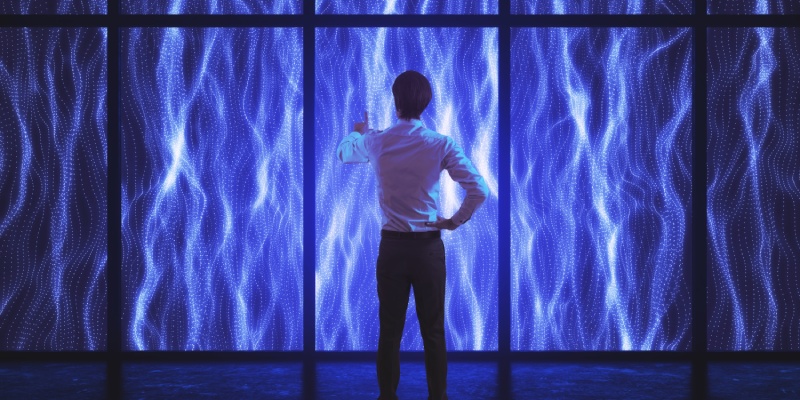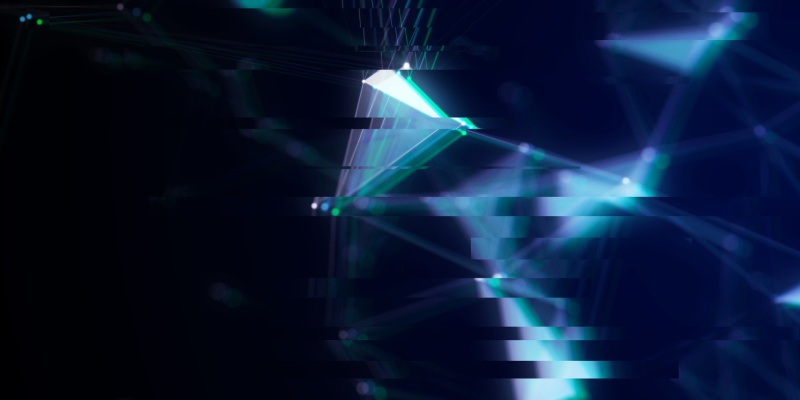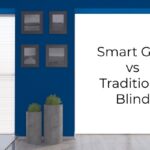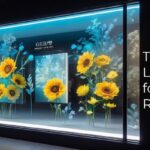In the dynamic realm of visual tech, holographic rear projection film astounds. Imagine visuals dancing in the air, a realm beyond screens. It’s real, not sci-fi. This innovation intertwines light and creativity, reshaping entertainment and business displays. This film marks a visual renaissance, altering how we perceive and present ideas – a futuristic marvel at the vanguard of innovation.
Definition and Concept Of Holographic Rear Projection Film
It is a specialized, transparent material designed for rear projection. It utilizes light diffusion and reflection principles to create lifelike three-dimensional visuals. This breakthrough turns any surface into a canvas for holographic displays, offering a captivating and dynamic viewing experience.
How It Works
- Light Source Illumination: The process begins with a light source, usually an LED or laser projector, emitting light toward the holographic film.
- Encoding Information on Film: This light carries information (visual data) encoded onto the holographic film’s surface. The film contains microstructures that diffract light in specific ways.
- Interference Patterns Formation: As light hits the film, it forms interference patterns due to its interaction with the microstructures. These patterns encode the visual data in a way that recreates the intended image or video.
- Reflection and Projection: The diffracted light patterns are reflected off the holographic film, projecting a reconstructed three-dimensional image into space.
- Viewing Angle and Perception: Unlike traditional displays, rear projection offers a wider viewing angle. This enables multiple viewers to see the 3D image from different perspectives without special glasses or devices.
- Creation of Illusion: The culmination of these processes results in the illusion of a holographic image. This image appears suspended in mid-air, providing a captivating visual experience that seems to exist in real space.
This stepwise process combines intricate light manipulation and specialized film technology to generate mesmerizing holographic visuals that captivate audiences.
Applications Of Holographic Rear Projection Film

Holographic rear projection film has transcended the boundaries of traditional visual displays. It opens up a realm of innovative applications that redefine how we perceive and interact with visuals.
Immersive Theatrical Experiences
This projection film transforms traditional theatres into immersive spaces, where characters and scenes come to life, enveloping the audience in a captivating visual spectacle. This application enhances storytelling and audience engagement in ways previously unimaginable.
Dynamic Live Events and Performances
Live events, concerts, and performances benefit from the dynamic visuals created by rear projection film. Artists and performers can interact with holographic elements, elevating the overall experience for the audience and pushing the boundaries of live entertainment.
Interactive Learning Environments
In educational settings, holographic projection film takes learning to a new level. Subjects come alive, allowing students to interact with 3D models and simulations. This application enhances comprehension and engagement, making complex concepts more accessible.
Innovative Corporate Presentations
Businesses leverage rear projection film for dynamic and innovative presentations. The technology transforms boardrooms, allowing presenters to showcase products, data, and concepts in a visually striking manner, fostering better communication and collaboration.
Trade Shows and Exhibitions
Holographic displays are becoming a staple at trade shows and exhibitions. Companies use holographic projection film to showcase products and services in a visually impressive way, attracting attention and leaving a lasting impression on attendees.
Virtual Fashion Shows
The fashion industry embraces holographic technology for virtual fashion shows. Designers can present their collections in a digital space, eliminating the need for physical runway setups. This application allows for creative and immersive showcases of clothing designs.
Medical Training Simulations
In the field of medicine, a rear projection film holographic finds application in training simulations. Medical professionals can interact with 3D holographic representations of anatomical structures, enhancing the training experience and improving skills in a risk-free environment.
Architectural Visualization
Architects and designers use rear projection film to visualize and present architectural designs. This application enables clients and stakeholders to experience a realistic 3D representation of buildings and spaces, aiding in decision-making and project communication.
Advantages of Holographic Rear Projection Film

Integrating holographic rear projection film into visual displays offers a myriad of advantages, revolutionizing the viewing experience and expanding the possibilities of visual communication.
High Contrast and Brightness
With high contrast and brightness, this projection film ensures vivid and visually striking holographic images, enhancing the overall viewing experience even in well-lit environments.
Wide Viewing Angles
Providing wide viewing angles, rear projection film holographic allows audiences to experience holographic visuals from various perspectives, maintaining engagement in diverse settings.
Flexibility in Display Sizes
The flexibility of holographic projection film allows for the creation of displays in various sizes, making the technology adaptable to different environments and applications.
Minimal Space Requirements
Displays created with this projection film require minimal space, a significant advantage for businesses and events with space constraints, offering a compact yet impactful visual solution.
Ease of Installation
Installing holographic rear projection film is a straightforward process, contributing to its widespread adoption and ensuring businesses and organizations can integrate the technology into their setups with minimal disruption.
Energy Efficiency
This rear projection film tends to be more energy-efficient compared to some traditional displays, aligning with growing concerns about sustainability and energy conservation.
Customizable Content
The ability to customize holographic content according to specific needs is a significant advantage, allowing businesses, educators, and event organizers to tailor visuals to their requirements for a more personalized and impactful experience.
Integration with Interactive Elements
Seamlessly integrating with interactive elements, such as touchscreens or motion sensors, holographic rear projection film enhances user engagement, making the overall experience more immersive and participatory.
Challenges and Limitations
- Image Clarity: Achieving consistent high image clarity across large display areas remains a significant challenge. Ensuring sharpness and quality, especially in intricate visuals, poses ongoing difficulties.
- Viewing Angles and Perspectives: Optimal viewing angles for holographic images can be limited, impacting the effectiveness and clarity of visuals from extreme side angles. Addressing this limitation is crucial for a more immersive experience.
- Equipment and Installation Costs: The implementation of holographic rear projection film often comes with higher upfront costs due to the need for specialized equipment and installation expertise. Affordability and accessibility could be limiting factors for widespread adoption.
- Space and Environment Requirements: Specific environmental conditions may be necessary for the technology to perform at its best, such as controlled lighting or precise projector-to-film distances. These requirements can restrict the applicability of holographic displays in various settings.
- Content Production Challenges: Developing content tailored for holographic displays presents a unique challenge. The creation of 3D holographic content demands specialized skills and software, potentially limiting the variety and availability of content for these displays.
- Ongoing Technological Advancements: The fast-paced evolution of holographic technology raises concerns about the longevity of current solutions. Staying current with technological advancements becomes a perpetual challenge for manufacturers and users, impacting the sustainability of their investments.
Conclusion
In conclusion, holographic rear projection film emerges as a game-changer in the realm of visual displays. Its impact on entertainment, education, business, and daily life is profound, offering a glimpse into a future where visuals transcend the confines of traditional screens. As technology continues to evolve, the potential for groundbreaking applications and experiences is limitless.
FAQs
Can holographic rear projection film be used outdoors?
Yes, advancements in technology have made outdoor applications possible, providing new opportunities for events and installations.
How does holographic technology differ from augmented reality?
While both involve overlaying digital content onto the physical world, holographic technology creates three-dimensional images without the need for physical devices like AR glasses.
Are holographic displays safe for prolonged viewing?
Holographic displays are designed with user safety in mind, and precautions are taken to ensure comfortable viewing experiences.
What are the power requirements for holographic rear projection film?
Compared to some traditional displays, holographic technology tends to be more energy-efficient, contributing to its environmental appeal.
Can holographic rear projection film be retrofitted to existing display setups?
Depending on the specific setup, retrofitting may be possible. Still, it’s essential to consult with experts for compatibility and optimal performance.





